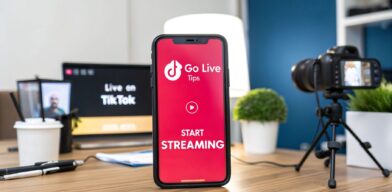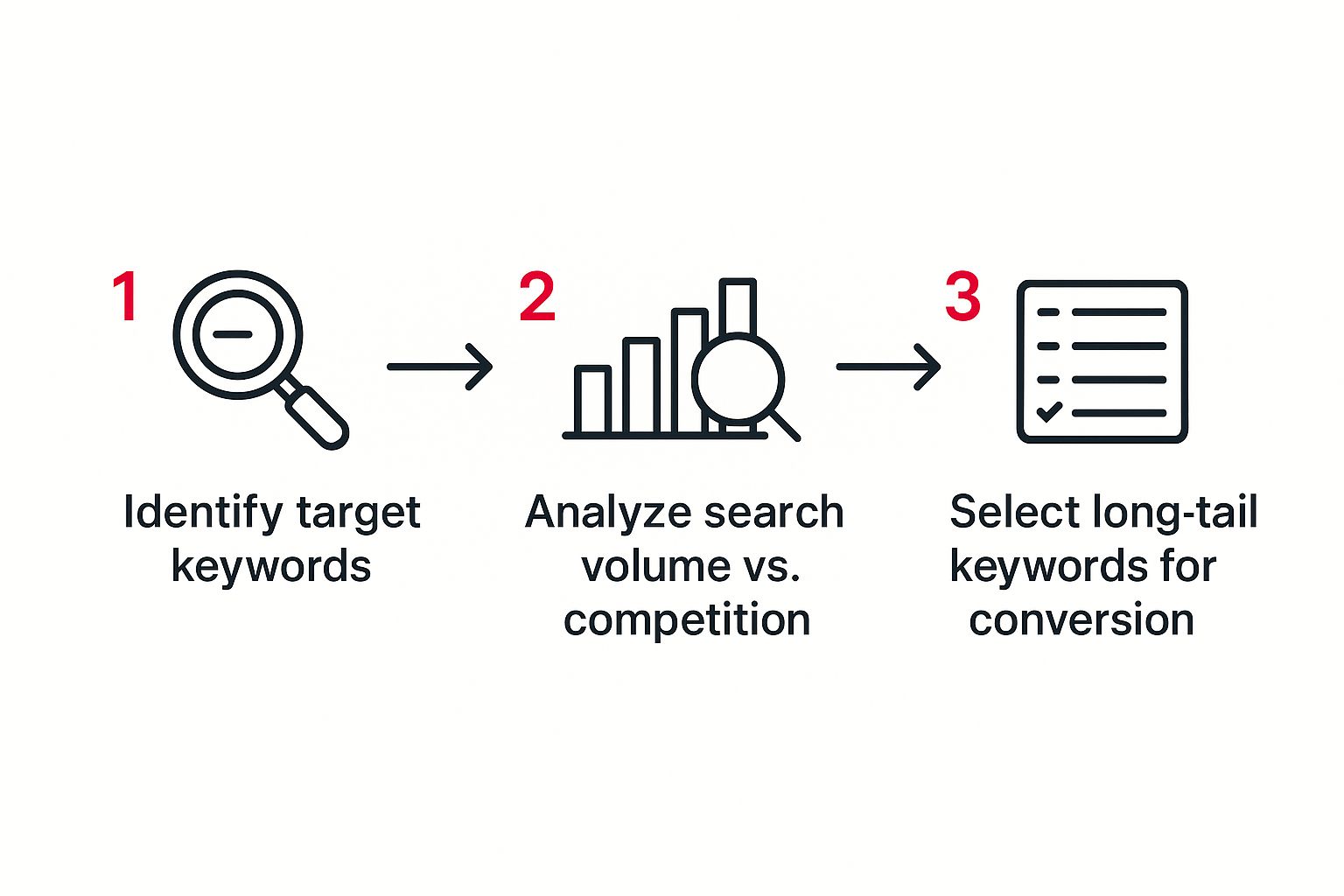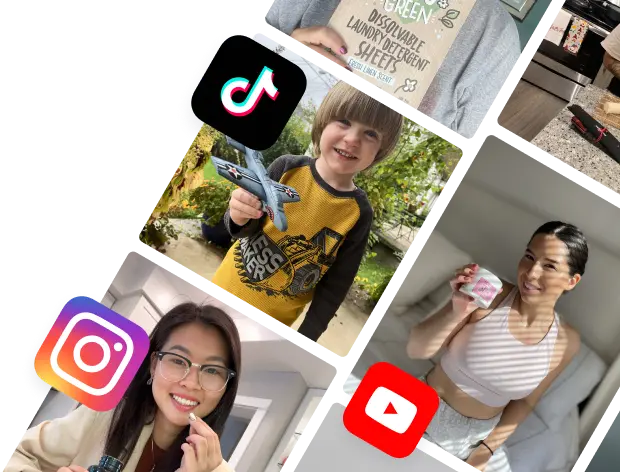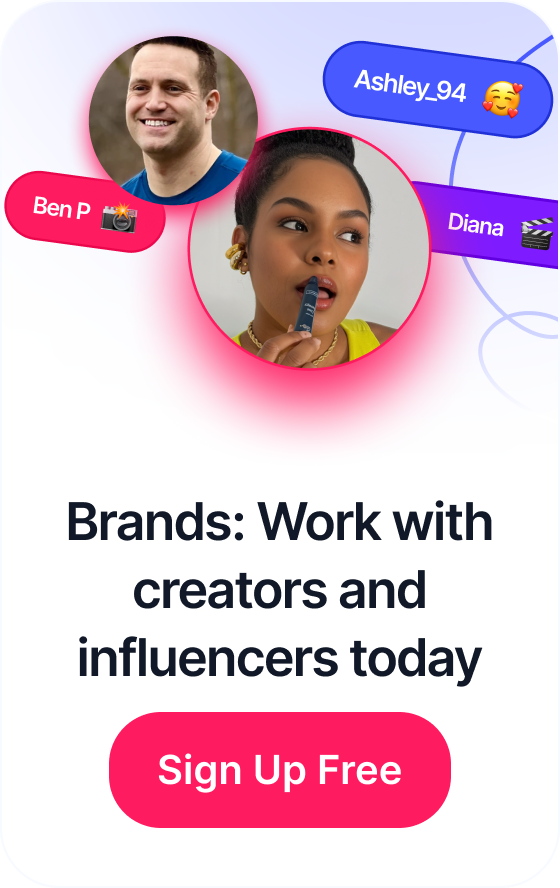 How to Going Live on TikTok: Easy Tips for Beginners
How to Going Live on TikTok: Easy Tips for Beginners
Table of Contents
Why Most Ecommerce Content Strategies Miss The Mark
Let’s be honest, most ecommerce content is just noise. Endless product features, cheesy stock photos, and generic descriptions you could slap on any brand. It’s like a digital used car salesman yelling about “amazing deals!” – and everyone’s tuning it out. I’ve chatted with so many store owners frustrated that their content isn’t converting. The problem? They’re focused on what they sell, not why anyone should care.
Think about your own online shopping habits. Are you drawn to a wall of technical specs? Probably not. You’re looking for solutions to your problems, stories you connect with, brands that get you. This is where most ecommerce content strategies fall short. They’re pushing products instead of building relationships. They’re talking at customers, not with them.
This old-school approach ignores how people actually shop now. We don’t just buy products; we buy into experiences, values, and communities. We want authenticity, connection, and content that genuinely helps. For example, a hiking boot brand could create content about trail maintenance, showcasing their environmental commitment and attracting like-minded hikers. That’s way more effective than just listing a boot’s waterproof rating.
To really make an impact, you need to plan out your ecommerce content strategy. This isn’t about chasing the latest trend; it’s a fundamental shift in how we create content. It’s about understanding your customer’s psychology and crafting content that speaks to their motivations, anxieties, and dreams.
The importance of a solid ecommerce content strategy is amplified by the massive growth of online shopping. The B2C market alone is projected to hit $3.67 trillion by 2025, growing at 9.7% annually. This huge growth highlights the need for content that truly resonates. For example, 59% of B2C consumers say email marketing influences their buying decisions, showcasing the power of targeted content. Plus, the use of AI in B2C is expected to more than double from 2023 to 2025, indicating a move toward personalized, tech-driven strategies. Discover more insights.
The brands that get this are the ones that will succeed. They’re building loyal communities, not just chasing clicks. They’re seeing real results, not just vanity metrics. They understand that content isn’t just about selling; it’s about connecting.
Getting Inside Your Customer’s Head
Forget generic buyer personas. To build a killer ecommerce content strategy, you need to really understand your customers. What motivates them? What are their pain points? And what finally makes them click “Buy Now”? I’ve seen how digging deeper than basic demographics can completely change the game.
One of the most powerful tools in your arsenal? Customer interviews. Skip the generic surveys and have real conversations. Ask open-ended questions that encourage your customers to share their stories. For example, instead of asking, “How satisfied are you with our product?”, try something like, “What problem were you hoping this product would solve?”. That small shift can unlock a goldmine of insights.

Social media listening is another crucial piece of the puzzle. It’s about more than just tracking brand mentions. Dive into relevant hashtags and groups. What are people saying about your brand – and your competitors? What are their biggest frustrations? This intel can tell you exactly what kind of content to create. I once discovered a huge, untapped demand for vegan leather alternatives just by listening to conversations in online communities. It led to a whole new content series and a successful product line.
Analyzing Your Competition
Don’t just copy your competitors. Figure out what actually works for them. Which blog posts are getting shared like crazy? Which product descriptions are converting best? Then, look for the gaps. What aren’t they talking about? Where are their blind spots? That’s where you can stand out and create content that truly resonates with your audience.
Understanding your target audience is fundamental to any ecommerce content strategy. This means understanding not just demographics (age, gender, location) but also psychographics (interests, lifestyle). By tailoring your content, you can drive deeper engagement and sales. For instance, 21% of marketers say short-form videos have the highest ROI – proving the importance of adapting content formats. Staying on top of trends like AI and personalized marketing is essential, too. Want to dive deeper into ecommerce marketing stats? Check out this resource: Sixth City Marketing.
Post-Purchase Power
Post-purchase surveys are another goldmine of information. Don’t just ask, “How was your experience?”. Go deeper. Ask, “What ultimately convinced you to buy?” or “What almost stopped you from buying?”. This can reveal the emotional triggers behind purchasing decisions.
To help you gather crucial customer data, let’s look at a variety of research methods:
Understanding your audience goes beyond simple demographics. The table below outlines some powerful research methods you can use to build a strong foundation for your content strategy:
Customer Research Methods for Ecommerce Content Strategy
Comparison of different research methods, their effectiveness, time investment, and best use cases for understanding your ecommerce audience
| Research Method | Effectiveness Rating | Time Investment | Best For | Cost Level |
|---|---|---|---|---|
| Customer Interviews | High | Medium-High | Deep qualitative insights, understanding motivations | Medium |
| Social Media Listening | Medium | Ongoing | Identifying trends, understanding customer conversations | Low-Medium |
| Competitor Analysis | Medium | Medium | Identifying content gaps, understanding market trends | Low |
| Post-Purchase Surveys | High | Low-Medium | Understanding purchase drivers, identifying pain points | Low |
| Customer Surveys | Medium | Low | Gathering quantitative data, understanding general preferences | Low |
| Focus Groups | High | High | Exploring complex topics, gathering group feedback | High |
As you can see, different methods offer varying levels of insight and require different levels of investment. Choosing the right mix for your business is key.
Speaking of connecting with your audience, have you considered user-generated content? Check out our guide on user-generated content strategy.
Turning all this feedback into compelling content requires a framework. Organize your findings into themes and prioritize the most impactful insights. This will help you create content that directly addresses customer needs, anxieties, and aspirations. Remember, understanding your customer isn’t a one-time thing; it’s an ongoing process. Continuously gather feedback, adapt your strategy, and watch your sales take off.
Matching Content To Your 5 Customer Journey Stages
I see this all the time: ecommerce brands creating content without a real understanding of their customer’s buying journey. It’s like trying to find your way in the dark without a flashlight. Let me shed some light on this with a framework for mapping content to each stage of the customer journey, from first discovering your brand to becoming a loyal advocate.
The goal isn’t to create more content, but the right content at the right time. Imagine going on a first date and immediately proposing. A little too much, too soon, right? The same applies to blasting product demos at someone just learning about your brand.

This infographic shows how to choose keywords based on search volume and competition. Analyzing both helps you pinpoint those valuable long-tail keywords that can really drive conversions. This targeted approach helps your content resonate with specific customer needs at each stage of their buying journey.
Understanding The Stages
Let’s break down the typical customer journey and the content that works best for each:
- Awareness: Think of someone realizing they have a problem and starting to explore solutions. This is where educational content comes in. Blog posts, infographics, or videos that address their pain points without a hard sell are perfect. For instance, if you sell organic skincare, create content about common skin problems and natural solutions.
- Consideration: At this stage, they know about your brand and are weighing their options. Now’s the time to build trust and show off your expertise. Case studies, product comparisons, and tutorials are your go-to tools. Explain why your product stands out.
- Decision/Purchase: They’re almost ready to buy, but might still have a few questions. Address those concerns head-on with product demos, customer testimonials, and special offers to give them that final nudge.

This screenshot illustrates the many touchpoints a customer might encounter. By mapping these out, you can find the perfect opportunities to deliver relevant content that guides them towards a purchase.
- Loyalty: Congratulations, they bought something! Now, let’s turn that one-time purchase into repeat business. Exclusive content, loyalty programs, and personalized recommendations make customers feel valued and appreciated.
- Advocacy: The ultimate goal! They love your brand so much they tell everyone about it. Fuel this enthusiasm with referral programs, user-generated content campaigns, and community building.
Identifying Buying Signals
Pay close attention to customer behavior. What are they searching for online? What pages are they browsing on your website? Are they adding items to their cart but abandoning it before checkout? These buying signals tell you where they are in their journey and what content they need next.
Let’s say someone reads several blog posts about a specific product. They’re probably in the consideration phase. A targeted email with a product comparison or a case study could be just the thing they need.
Remember, this framework isn’t about manipulating customers. It’s about being helpful. By giving them the right information at the right time, you’re guiding them to the solution that best meets their needs. That’s how you build a successful business and happy customers.
Content That Converts Browsers Into Buyers

Let’s be honest, likes are great, but they don’t pay the bills. What does move the needle is content that speaks directly to the hesitations and worries a potential customer has before hitting that “buy now” button. I’ve seen this happen time and time again. Truly understanding what’s going on in a customer’s mind when they’re considering a purchase? That’s game-changing. It’s not about being pushy; it’s about building real trust.
Crafting Compelling Product Stories
Think about it: Nobody wants to read a boring list of features. Instead, weave those features into a compelling product story. What problem does your product solve? How does it make someone’s life better? Let’s say you’re selling a coffee maker. Instead of saying it “brews 12 cups,” paint a picture. Talk about waking up to the smell of fresh coffee, sharing a pot with family, and enjoying that quiet moment before the day starts. Tap into the feeling behind the purchase.
That’s what resonates.
The Power of Social Proof
Social proof is more than just testimonials sprinkled across your site. It’s about showing real people using and loving your product. Think authentic user-generated content on platforms like Instagram and TikTok, video reviews on YouTube, and influencer collaborations that feel genuine, not forced. Real experiences build trust and make that purchase feel less risky. People are far more likely to trust a fellow customer’s rave review than a perfectly polished ad.
Overcoming Price Objections and Purchase Anxiety
Price is often the biggest sticking point. Don’t avoid it. Address it directly. Create content that explains the value. Maybe you break down the cost per use, highlight the long-term benefits, or offer payment plans. Acknowledge those purchase anxieties. A clear return policy, a money-back guarantee, and top-notch customer service can go a long way in calming those fears and building confidence.
Creating good content consistently is a challenge. If you’re feeling the pressure, check out this helpful resource: How To Scale Content Creation.
Creating Authentic Urgency
Urgency can be effective, but it has to be real. Limited-time offers, exclusive bundles, or early bird discounts can create excitement without feeling pushy. Highlighting scarcity, like limited stock, can also work. But remember, honesty is paramount. Don’t fake scarcity. It’ll backfire and damage trust.
Content marketing in ecommerce is incredibly effective because it drives real ROI. Some studies even show that every dollar spent can generate up to $42 in return. This is partly due to how engaging content builds customer loyalty. Want to dive deeper? Learn more about ecommerce content strategies and ROI.
From One-Time Buyers to Repeat Customers
The end goal isn’t just a single sale. It’s building a lasting relationship. Keep your customers engaged with valuable content even after they’ve bought something. Personalized product recommendations, exclusive content for loyal customers, or early access to new releases can build a sense of community. Turning a one-time buyer into a brand advocate? That’s the ultimate goal. It’s about fostering loyalty, not just chasing transactions.
Smart Distribution That Actually Reaches Customers

Creating killer content for your ecommerce store is just the first step. What’s the point of a fantastic blog post if it’s gathering digital dust? This is where smart distribution comes in – going beyond just hitting “publish” and crossing your fingers. Trust me, I’ve been there, and strategic distribution is as crucial as the content itself. Think of it like baking an amazing cake only to hide it in the pantry. No one gets to enjoy it!
Finding Your Audience’s Hangouts
First things first: you need to know where your customers are actually spending their time online. Are they obsessed with Instagram? Hanging out in Facebook groups? Searching for inspiration on Pinterest? Don’t waste precious time and resources on platforms your target audience isn’t using. For example, if you’re selling luxury fashion, TikTok might be a smarter move than LinkedIn. It’s not about being everywhere, it’s about being where you’ll actually connect. And don’t forget the power of reviews! Actively asking for a review can significantly increase conversions.
The Right Channel for the Right Content
Once you know where your audience is, it’s time to figure out what kind of content resonates on each platform. A detailed blog post might do well on your website, but a short, engaging video is likely better for Instagram. Infographics can be incredibly effective on Pinterest, while quick text posts might be ideal for Twitter. Matching the content format to the platform is essential for getting noticed and sparking engagement.
Repurposing Content Like a Pro
Constantly creating brand-new content can feel like a marathon. This is where the magic of content repurposing comes in. It’s not about being lazy, it’s about being efficient. Take that long-form blog post and transform it into a series of Instagram posts, a quick YouTube video, or even a Pinterest infographic. The trick is to add something new each time. Don’t just copy and paste. Tweak the message, change the format, and offer a new perspective.
Building Authentic Influencer Relationships
Influencer marketing can be a game-changer for reaching new customers. But it’s not about throwing money at anyone with a large following. It’s about building real relationships with influencers who truly align with your brand and resonate with your audience. These collaborations should feel organic, not forced. Think long-term partnerships, not just one-off sponsored posts.
Harnessing the Power of User-Generated Content
User-generated content (UGC) is word-of-mouth marketing amplified. Encourage your customers to share their experiences with your brand. Run contests, offer rewards, and make it easy for them to create and share content. UGC not only offers valuable social proof, but also gives you a steady flow of authentic, relatable content.
Email Marketing That Doesn’t Suck
Email marketing is still one of the most effective ways to build connections with customers and drive sales. But no one wants their inbox flooded with generic promotional emails. Focus on giving them something valuable. Share exclusive content, offer personalized recommendations, and cultivate relationships with engaging email sequences that people actually want to read. Email is about nurturing leads and fostering loyalty, not just blasting sales pitches.
Creating a Cohesive Experience Across Platforms
Your ecommerce content strategy should feel like a symphony, not a bunch of random notes. Coordinate your content across all platforms to create a unified customer experience. This might involve having a consistent visual identity, using the same messaging, or linking your social media back to your website. This makes your brand feel more professional and memorable. Think about the customer journey and how each piece of content plays a role in the bigger picture.
Let’s take a closer look at distribution channel performance with some real data:
To help illustrate how different channels perform, I’ve put together a table summarizing some key metrics.
| Channel | Average Reach | Engagement Rate | Conversion Rate | Best Content Types |
|---|---|---|---|---|
| High | Medium | Low-Medium | Videos, Images, Stories | |
| Medium | High | Medium | Images, Stories, Reels, Carousels | |
| Medium | Medium-High | Medium-High | Infographics, Images, Product Pins | |
| High | Low | Low | Short-form text, News, Links | |
| Medium | Medium-Low | High | Newsletters, Product announcements, Personalized offers | |
| YouTube | High | Medium | Medium | Long-form videos, Tutorials, Reviews |
| TikTok | High | High | Medium-Low | Short-form videos, Trending content, Challenges |
This table shows how each channel has its strengths and weaknesses. While Facebook has a broad reach, Instagram tends to have higher engagement. Email, despite a lower engagement rate, can have high conversions. Choosing the right mix of channels for your specific business and audience is key.
By carefully considering the nuances of each platform and tailoring your content accordingly, you can build a distribution strategy that actually connects with your audience, boosts engagement, and drives sales. It’s about creating a conversation, not just broadcasting a message.
Tracking What Actually Matters For Revenue
Page views and likes are vanity metrics. They might give you a temporary ego boost, but they don’t bring in the cash. I’ve worked with so many brands obsessed with these surface-level numbers, only to realize later they weren’t moving the needle on what truly matters: revenue. Let’s ditch the vanity metrics and dive into the data that actually fuels growth.
Setting Up Proper Attribution
I can’t stress this enough: proper attribution is crucial. You absolutely need to know which pieces of content are actually driving sales. Simply tracking last-click attribution won’t give you the full picture. Think about the entire customer journey – it’s rarely a straight line. Are your blog posts subtly influencing purchasing decisions? Are your videos leading to add-to-carts?
Tools like Google Analytics can be game-changers here. They allow you to track customer behavior across multiple touchpoints, revealing the real influence of your content. Take a look at this Google Analytics dashboard example:
This dashboard highlights key metrics like conversion rate and revenue generated. By analyzing this data, you can pinpoint exactly which content is contributing to sales and uncover opportunities for optimization.
For example, let’s say a customer discovers your brand through a blog post about eco-friendly packaging. A week later, they see a retargeting ad featuring a product mentioned in that blog post and finally make a purchase. Without proper attribution, you might mistakenly credit the ad for the entire sale, completely overlooking the blog post’s initial impact.
Measuring Lifetime Value Impact
Don’t just focus on individual sales; think long-term. Which content pieces are attracting customers who become loyal, repeat buyers? This is where understanding the customer journey becomes invaluable. Content that resonates with your ideal customer and fosters long-term loyalty is gold. It’s far more valuable than content that generates a single purchase and then fades into obscurity. For more insights on this, you might find this helpful: measuring the ROI of your influencer marketing.
A/B Testing for Actionable Insights
A/B testing is your secret weapon for optimizing content performance. Experiment with everything: headlines, calls to action, images, even different content formats. Don’t rely on guesswork; let the data guide you. I once worked with a client who saw their conversion rate double just by changing a button color from green to orange. It’s amazing how small tweaks can have a significant impact. Effective content distribution is key, and for those of you also working with podcasts, this resource on how to market a podcast could be super useful.
Regular Content Audits
Regular content audits are like spring cleaning for your website. They help you identify what’s performing well and what’s just taking up space. Analyze metrics like traffic, engagement, conversions, and LTV impact. Don’t be afraid to remove content that’s not pulling its weight. Sometimes, less is more. By focusing your efforts on the content that’s genuinely driving revenue, you can maximize your impact and achieve your business goals. This is about turning your content into a profit center, not just a collection of blog posts.
Your Implementation Roadmap For Content Success
Let’s get down to brass tacks and translate all this into a roadmap you can use right now. The goal isn’t to pile on more work, it’s to build a system that actually integrates with your current resources. I’ve seen this work wonders, turning what felt like a content avalanche into a steady, manageable stream.
Audit Your Current Content Performance
Before you even think about creating new content, take stock of what you’ve already got. Think of it like spring cleaning for your website and social media. What’s bringing in the customers? What’s gathering digital dust? Look at the hard data: traffic, engagement, and conversions. And don’t be shy about hitting the delete button on anything that’s underperforming.
- Analyze Website Traffic: Where are people landing on your site? More importantly, are those pages actually turning visits into sales? Google Analytics is your friend here – it’ll show you the pathways your customers are taking.
- Review Social Media Engagement: Which platforms are buzzing with activity? What kind of content gets people talking, sharing, and liking? This is where you’ll find your social media sweet spot.
- Assess Content Gaps: What are your customers asking about that you haven’t answered yet? Peek at your competitors – are they covering ground you’ve missed? This is your opportunity to become a go-to resource.
Prioritize Improvements for Maximum Impact
Once you’ve spotted areas that need some love, focus on the changes that will give you the biggest return. Maybe it’s polishing up high-traffic pages, doubling down on popular social media posts, or crafting fresh content to fill those gaps you’ve identified. Don’t spread yourself too thin; concentrate on making a real difference where it counts.
- Optimize High-Traffic Pages: Sometimes the smallest changes have the biggest impact. Speed up your page load times, make sure your images are optimized, and make those calls to action sing.
- Expand on Popular Content: Did a blog post or social media update go gangbusters? Think about creating more content around that same topic. A follow-up blog, a series of social posts, or even a video could keep that momentum going.
- Create New Content to Address Gaps: By filling in content gaps, you can snag new customers and position your brand as an industry leader. Keyword research is your secret weapon – use it to find out what your audience is searching for.
Build Sustainable Content Creation Processes
Content creation shouldn’t feel like an endless marathon. Put systems in place to smooth out your workflow. This might mean designing content templates, setting up an editorial calendar, or using project management tools to keep everything organized and running like a well-oiled machine.
- Content Templates: Templates are a lifesaver. They save you time and make sure your branding is consistent. Think templates for blog posts, social media updates, and even your email newsletters.
- Editorial Calendar: An editorial calendar is like a roadmap for your content. It lets you plan and schedule your posts, ensuring a steady flow of valuable info for your audience.
- Project Management Tools: Tools like Trello or Asana help you keep track of deadlines, assign tasks, and make sure everyone’s on the same page. Especially helpful if you’re juggling a whole team of content creators.
Set Realistic Goals and Track Your Progress
Set SMART goals: Specific, Measurable, Achievable, Relevant, and Time-bound. Don’t go for vague ideas like “increase brand awareness.” Instead, shoot for concrete goals like “increase website traffic by 20% in the next quarter.” Tracking your progress is key. Regularly check your metrics and tweak your strategy as needed. This data-driven approach will keep you moving forward and help you hit those business objectives. It’s all about building momentum and celebrating those small wins.
Ready to give your ecommerce content strategy a serious upgrade and watch your brand grow? JoinBrands offers the tools and resources you need to connect with a wide network of creators and streamline your entire content creation process. Learn more about how JoinBrands can help you achieve content success.








